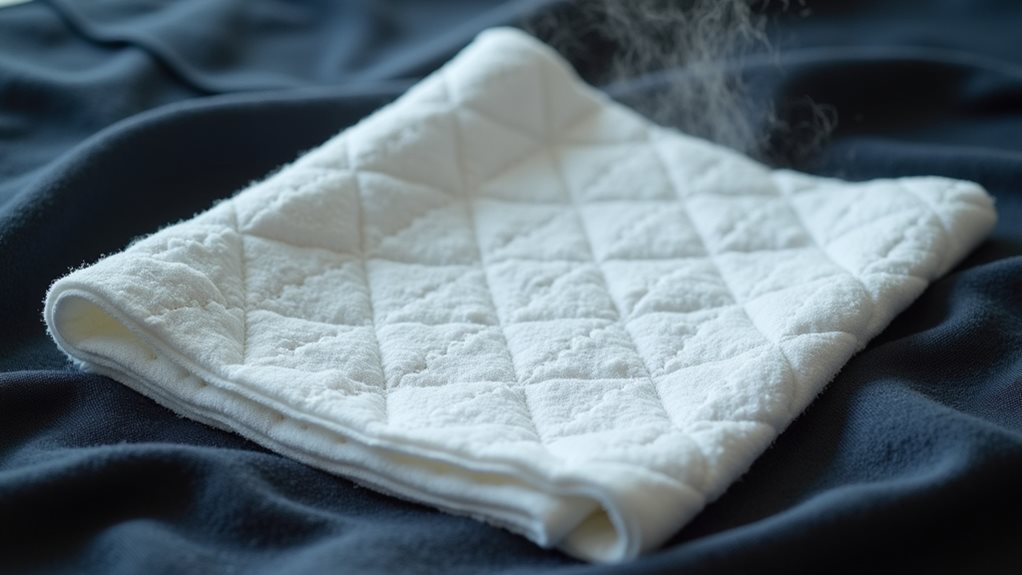Dry cleaning sheets work by releasing cleaning agents when your dryer’s heat activates them, creating a mini chemistry lab that refreshes your clothes without expensive trips to the cleaner. As the sheets tumble with damp garments, quaternary ammonium compounds and surfactants spread evenly across fabrics, tackling light stains and odors while reducing static cling and adding fresh scents. They’re perfect for maintaining everyday pieces like dress shirts, though they won’t handle heavy stains or give you that crisp professional finish you’d expect from traditional methods 😊 Understanding the complete process reveals why certain fabrics respond better than others.
What Are Dry Cleaning Sheets and How Do They Differ From Traditional Methods
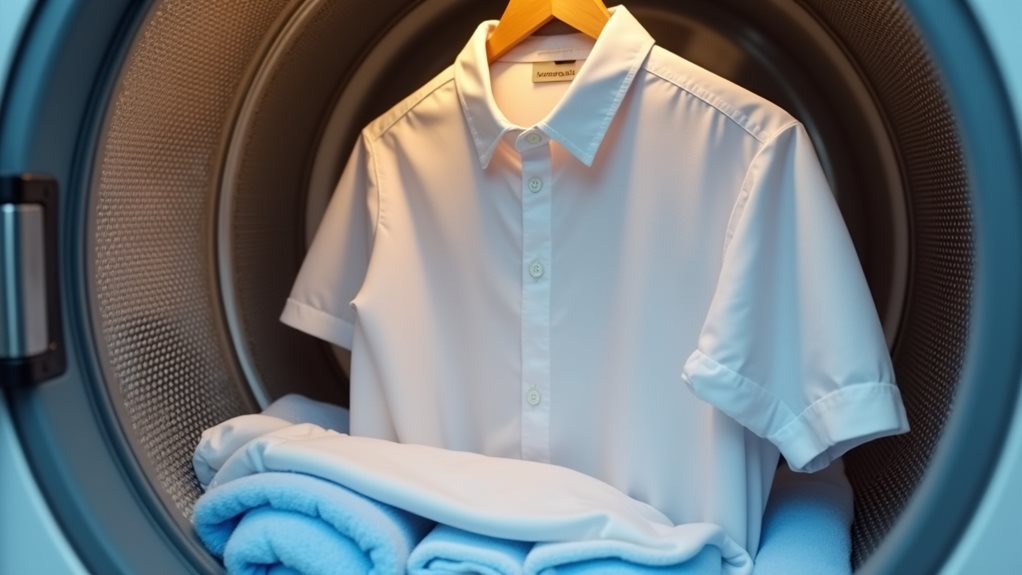
Innovation has this funny way of sneaking into our lives through the most mundane tasks, and dry cleaning sheets perfectly exemplify this quiet revolution happening right in your laundry room.
These clever little sheets are basically fabric refreshers that work their magic through heat and moisture, releasing cleaning agents that tackle light stains and eliminate odors without the harsh chemical solvents traditional dry cleaning relies on.
What makes them genuinely exciting is their versatility with delicate fabrics that might otherwise require expensive professional dry cleaning services. They’ll soften your clothes, reduce static cling, and leave everything smelling fresh – creating a convenient at-home solution that’s honestly changed how I approach garment care, even if they can’t match the deep-cleaning power of the pros.
While these sheets excel at refreshing lightly soiled garments and reducing wrinkles, they cannot handle deep stains or heavily embedded dirt that requires professional-grade equipment and specialized solvents.
The Science Behind Heat and Moisture Activation in Your Dryer
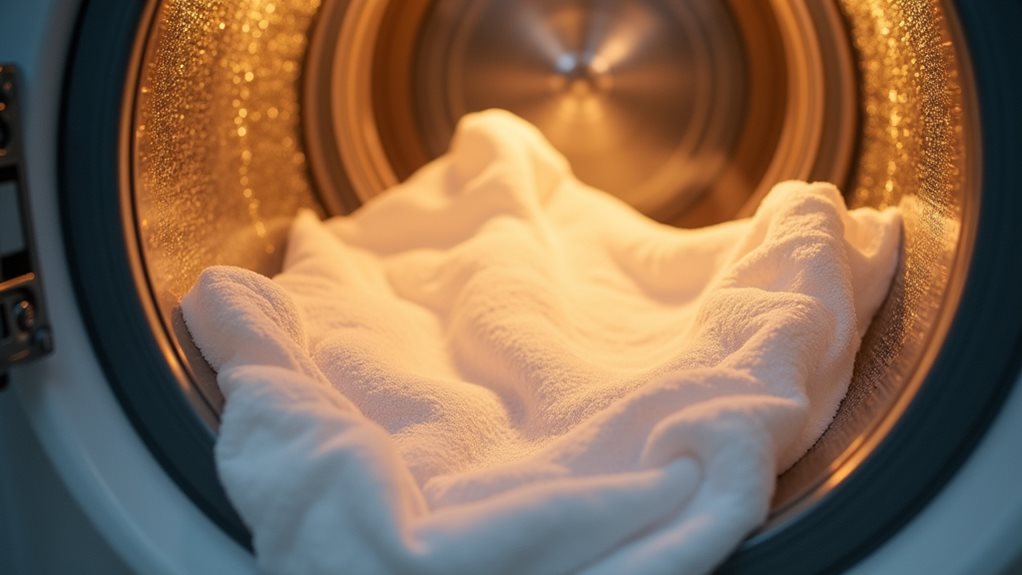
When you toss a dry cleaning sheet into your dryer alongside damp clothes, you’re fundamentally creating a miniature chemistry lab where heat becomes the catalyst that transforms those unassuming little squares into fabric-refreshing powerhouses.
The magic happens when your dryer’s heat causes those softening agents and fragrances to evaporate, spreading throughout the drum like invisible fairy dust ✨.
Meanwhile, the moisture from your damp clothes acts as the perfect accomplice, creating humidity that helps distribute these compounds evenly across your fabric fibers.
As everything tumbles together during the drying process, you’re basically coating each garment with a protective layer that banishes static cling and leaves everything smelling fresh.
Chemical Composition and Active Ingredients That Make Cleaning Possible
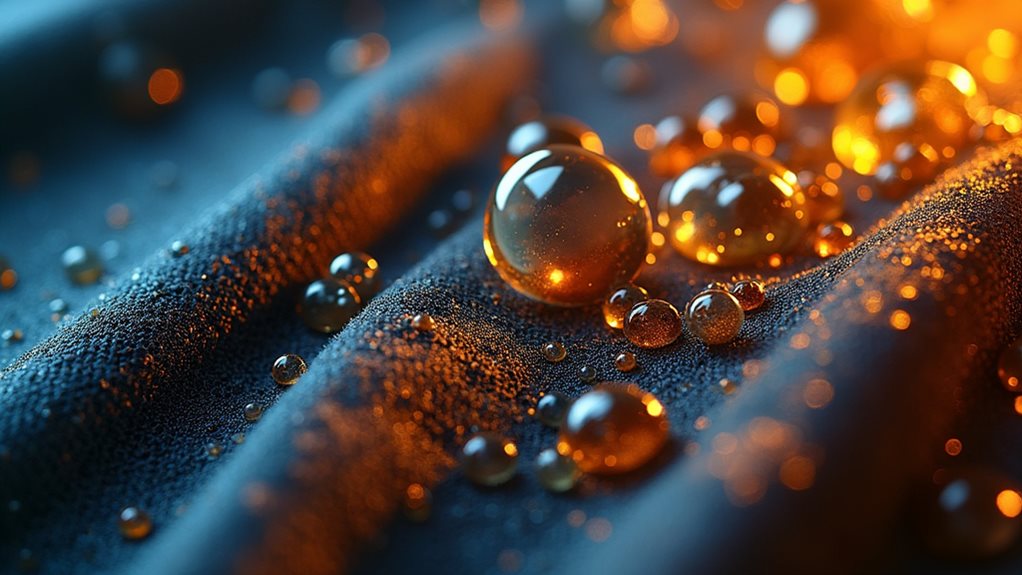
You know, when I first started wondering what actually makes those little dryer sheets work their magic, I discovered it’s really about three key players working together like a well-rehearsed team.
The quaternary ammonium compounds act as your fabric’s personal bodyguards, coating each fiber to banish static cling while making everything feel softer than a cloud ☁️.
Meanwhile, the surfactants and fragrance oils team up to tackle any remaining electrical mischief and leave your clothes smelling like they just came from the world’s most luxurious spa, though I’ll admit my definition of “spa-like” might be questionable given my tendency to get overly excited about laundry day.
Quaternary Ammonium Compounds
Beyond their softening powers, quats bring impressive antimicrobial properties to your laundry routine:
- Cleaning improvement – They inhibit bacteria and mold growth on textiles
- Freshness maintenance – Natural odor removal keeps clothes smelling pleasant longer
- Textile conservation – Protective coating helps preserve fabric integrity over time
Their unique chemical structure bonds effortlessly with fibers, delivering long-lasting results that keep your wardrobe feeling fresh and static-free.
Surfactants and Fragrance Oils
Working alongside those powerful quaternary ammonium compounds, surfactants act as the unsung heroes of your dryer sheets, quietly breaking down the invisible barriers that keep fabrics stiff and clingy.
These molecular peacemakers lower water’s surface tension, allowing moisture to spread evenly across fibers and tackle that annoying static cling that makes your clothes stick together like they’re plotting against you 😅.
Meanwhile, fragrance oils transform your mundane laundry experience into something almost spa-like, coating each fiber with scents that linger long after the dryer stops.
Together, these ingredients create a protective lubricating layer that reduces friction during tumbling, preventing static buildup while improving the overall cleaning effect that makes fabric softeners so wonderfully effective.
Step-by-Step Process of How Dry Cleaning Sheets Clean Your Garments
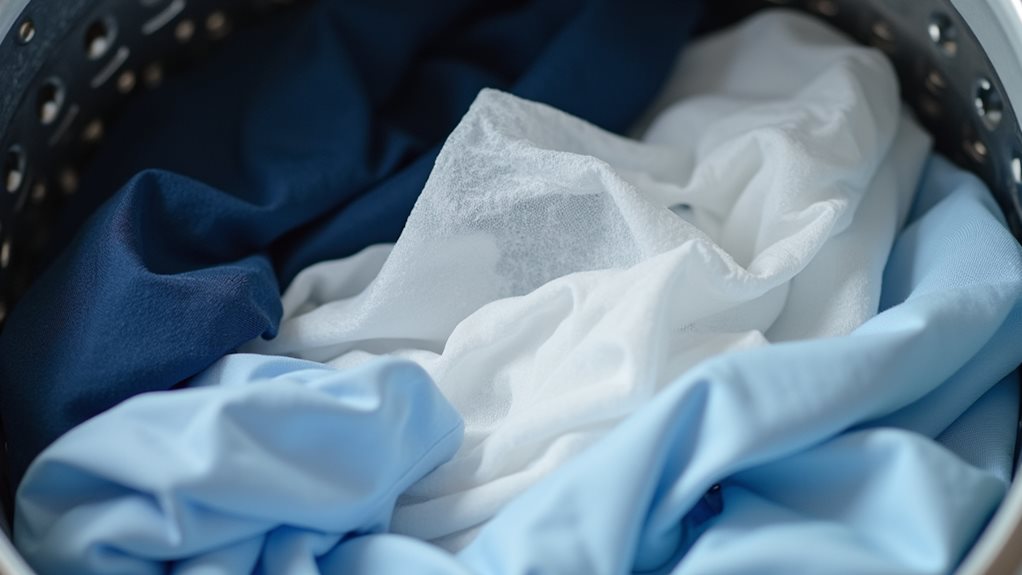
When you toss that wrinkled blazer into your dryer with a dry cleaning sheet, you’re fundamentally starting a mini chemistry experiment that would’ve made my high school science teacher proud 😊.
The moment your dryer heats up, those cleverly designed sheets begin their heat activation process, releasing their chemical payload like tiny fabric-care superheroes ready to tackle wrinkles, odors, and static cling.
As the drum tumbles your clothes around, the chemical coating application begins in earnest, with those quaternary ammonium compounds spreading across every fiber like a protective blanket that transforms your garments from “meh” to “magnificent.”
Heat Activation Process
The magic truly begins the moment you toss that dry cleaning sheet into your dryer and press start, because that’s when heat transforms this simple-looking fabric square into a powerful cleaning ally.
Once your dryer reaches medium or high heat, the heat activation process kicks into high gear, causing those carefully formulated softening agents to vaporize and work their gentle magic on your fabric fibers.
Here’s what happens during this fascinating transformation:
- The heat causes cleaning agents to release from the reusable sheets in vapor form
- These vaporized compounds coat your garments evenly as the dryer tumbles
- The process helps reduce static cling while softening fabrics without harsh chemicals
It’s honestly pretty amazing how something so simple can deliver such professional results right in your home! 😊
Chemical Coating Application
Once those cleaning agents transform into vapor, they begin their systematic expedition across every thread and fiber in your load, creating what I like to think of as a protective hug around each garment.
The chemical coating from your dry cleaning sheets distributes evenly, with softening agents and fragrance oils penetrating deep into fabric fibers through the tumbling action.
Those quaternary ammonium compounds I mentioned earlier work like tiny guardians, forming microscopic barriers that prevent static cling while keeping wrinkles at bay.
The non-woven fabric of the sheet acts as your delivery system, gradually releasing its payload of protective chemicals throughout the cycle.
While this at-home method works well for many garments, delicate fabrics and specialty items may still require professional dry cleaning services for optimal care and preservation.
It’s honestly fascinating how something so simple can transform rough, clingy clothes into soft, fresh-smelling garments!
Which Fabrics and Garment Types Work Best With Dry Cleaning Sheets

Why settle for expensive trips to the dry cleaner when you can refresh most of your wardrobe right at home? Dry cleaning sheets work wonders on a variety of fabrics, especially delicate materials like silk and cotton that benefit from gentle freshening.
You’ll find they’re perfect for lightly soiled garments that just need a quick refresh rather than deep cleaning.
These convenient sheets excel with:
- Natural fibers – wool sweaters and cotton blouses emerge beautifully softened
- Synthetic materials – polyester shirts lose static cling and regain crispness
- Everyday garment types – dress shirts, casual trousers, and delicate blouses
However, skip heavily beaded, sequined, or leather items since the chemicals can cause damage.
For your regular wardrobe rotation though, these sheets offer incredible convenience without compromising fabric care. Traditional dry cleaning uses chemical solvents like perchloroethylene to dissolve oils and grease while preserving delicate fabric integrity.
Comparing Effectiveness: Dry Cleaning Sheets Vs Professional Dry Cleaning
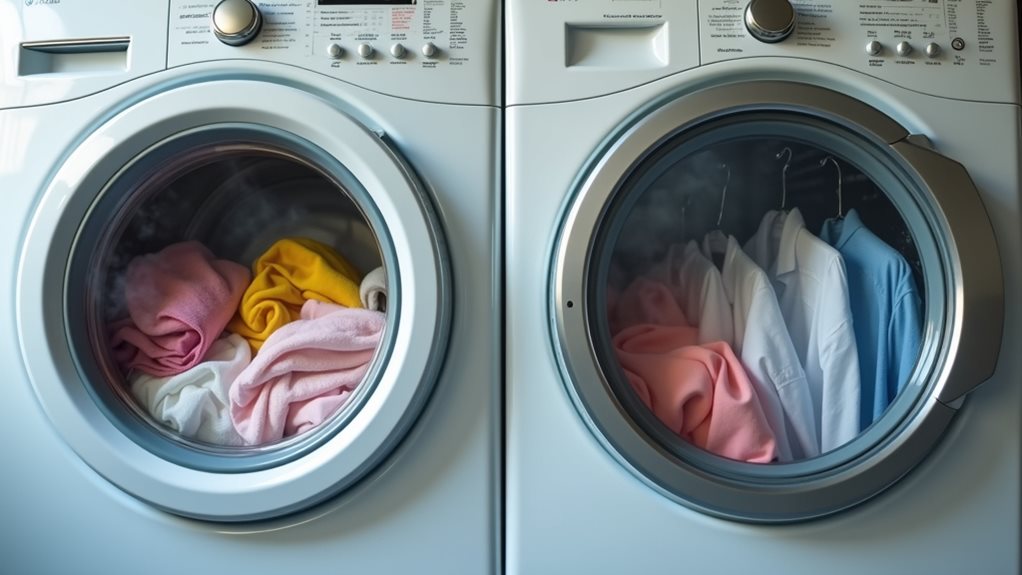
While both options promise to keep your clothes looking fresh, understanding when to reach for dry cleaning sheets versus heading to the professional cleaners can save you both money and disappointment.
Here’s the honest truth about effectiveness between these cleaning methods: dry cleaning sheets excel at garment maintenance between deep cleans, tackling light odors and wrinkles for about $0.50 per load—making them an economical option for busy weeks.
However, they can’t touch oil-based stains or provide that crisp finish your favorite blazer deserves.
Professional dry cleaning penetrates fabric fibers with specialized solvents, removing stubborn stains and delivering that pressed perfection you need for important meetings, though it’ll cost you $10-20 per piece. 💸
Professional dry cleaning also excels at maintaining delicate fabrics like silk and wool that require gentle care to preserve their integrity and prevent damage.
Environmental Impact and Safety Considerations of At-Home Dry Cleaning
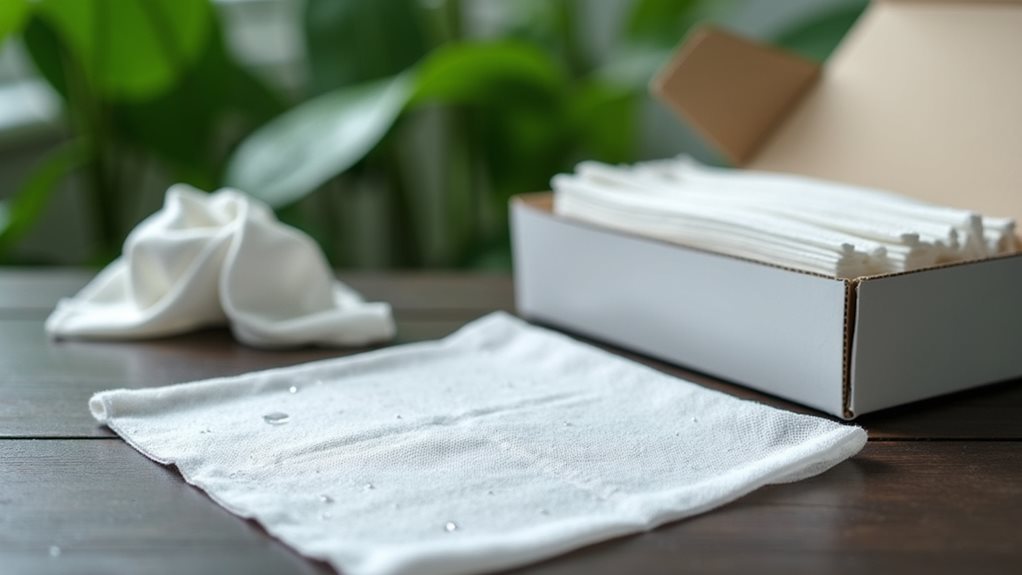
Beyond the dollars and cents of cleaning choices lies a bigger picture that honestly keeps me up at night sometimes—the environmental footprint we’re leaving behind with every wardrobe decision we make.
Every clothing care choice we make ripples outward, creating an environmental impact that extends far beyond our closets.
Here’s what I’ve discovered about dry cleaning sheets and their environmental impact:
- Biodegradable ingredients in many at-home dry cleaning kits reduce harmful chemical exposure compared to traditional solvents.
- Reduced carbon footprint from fewer trips to professional cleaners means less fuel consumption and energy use.
- Safety considerations require verifying product claims, as regulations on chemical-intensive cleaning products vary widely.
While these sheets minimize our exposure to harsh chemicals, responsible disposal remains essential.
I’ve learned that even eco-friendly products need proper handling—those chemical residues don’t just disappear! 🌱
Traditional professional dry cleaning relies heavily on perchloroethylene and other chemical solvents that pose greater environmental and health risks than most at-home alternatives.

